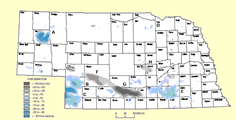Natural Resources, School of

Conservation and Survey Division: Faculty and Staff Publications
Document Type
Article
Date of this Version
1-17-2011
Citation
2011 Elsevier B.V. All rights reserved.
Abstract
Acidic weathering of the sulfidic Upper Cretaceous Carlile and Pierre Shales in Nebraska has led to the precipitation of the Al sulfate–hydroxide minerals aluminite, alunite, “basaluminite”/felsöbányaite (e.g.,), the aluminum hydroxides gibbsite and bayerite, and the rare Al phosphate hydroxide vashegyite. Kaolinite has also been produced as a result of this acidic weathering. These minerals do not appear as neoformed constituents in any extant soils in the region, and their existence underscores the ability of pyrite oxidation to produce major changes in mineralogy on a Holocene to Recent time scale. Jarosite, hydronium jarosite, gypsum, halotrichite, and melanterite also appear as secondary minerals in the weathered shales. Acidic weathering and the formation of new minerals is extrapedogenic because it occurs well below the limit of modern soil sola. These processes also occur at the edges of major landscape elements and can be considered to have a strong lateral component processes, making them “per latus” processes in our usage.
Included in
Geology Commons, Geomorphology Commons, Hydrology Commons, Paleontology Commons, Sedimentology Commons, Soil Science Commons, Stratigraphy Commons


Comments
Catena 85 (2011) 253–266 doi:10.1016/j.catena.2011.01.011